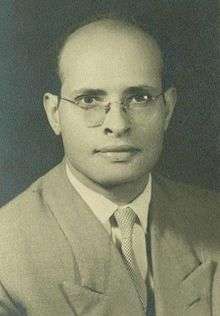Gamal Hamdan
Gamal Hamdan (Arabic: جمال حمدان) (February 4, 1928 – April 17, 1993) was an Egyptian scholar and geographer. Among his most prominent books are The Character of Egypt, Studies of the Arab World, and The Contemporary Islamic World Geography, which form a trilogy on Egypt's natural, economic, political and cultural character and its position in the world.

Birth
Hamdan was born in the Qalyubia Governorate on February 4, 1928. His father, a teacher of Arabic language, had been discharged from Al Azhar University educational institution on charges of participating in demonstrations in the Egyptian Revolution of 1919.
Education
At the age of eight, he joined the primary school. He then moved to the prestigious Tawfiqiyya secondary school, which had a nationwide fame for its high educational standard and sports facilities. There, he became aware of his love and innate talent for geography.
Having completed his secondary education in 1944, with distinction, ranking sixth on the list of graduates nationwide, he joined the Department of Geography at the Cairo University. Faculty of Arts.
At the age of twenty, he obtained his B.A. with Distinction.
He was soon appointed a staff member at Faculty of Arts, where he was granted a scholarship at the University of Reading, UK to obtain his M.A. and Ph.D. degrees. There, he was a student of the eminent English geographer, professor Austen Miller.
Career
Major viewpoints and thoughts
Hamdan’s intellectual and geographical achievements constituted the most important accomplishment of the Egyptian geographical school, that stresses Egypt’s uniqueness and singularity in terms of time and place, of geography and history. In his works, he adopted a multi-disciplinary approach, encompassing geography, history, sociology, politics and culture.
Hamdan’s writings clearly manifested a unique wealth of knowledge, an immense power of meditation and observation and a distinct, devoted love of Egypt. His was the connoisseur’s love of the components of a unique gem. Utilizing these exceptional resources, Hamdan could delineate and interpret the Egyptian personality as influenced by location and geographical considerations.
Major works
Hamdan left behind a rich legacy of writing in both Arabic and English languages, including seventeen books in Arabic and eight in English, in addition to several articles in Arabic, published in newspapers, magazines and other publications.
It is worthy of note that he had a futuristic outlook in his writings. He predicted several events, which, he thought, were compatible or incompatible with the facts of geography. Chief of these was his prediction of the disintegration of the Soviet Union.
His encyclopedic work The Personality of Egypt, the most outstanding of his intellectual achievements, was the product of ten years of dedicated efforts, during which time he used 245 Arabic language and 691 foreign reference books in several languages. In this prestigious book, he elaborately expounded the constituent factors making-up the Egyptian personality since the early days of the Pharaohs. To him, Egypt was the central chapter of the book of geography, that turned into the opening chapter of the book of history, maintaining all through a coherent civilization across history. Egypt, to Hamdan was a unique unrepetitive geographical anomaly. Apart from the “Description of Egypt”, which appeared in print during the French Expedition to Egypt, this book remains an unprecedented scientific masterpiece on Egypt.
Main prizes and merit awards
Dr. Gamal Hamdan won several scientific prizes and merit awards including:
State Incentive Prize for Arts and Letters, 1959. State Merit Prize for Social Science, 1986. Scientific Criticism Award, by the State of Kuwait, 1986. Order of Merit of the First Class for Science and Arts, 1988. In line with his full dedication to science and his almost ascetic attitude to formalities, he refused to break up with his self-imposed solitude. Apart from the first prize awarded to him in 1959, he refused to receive any of the other prizes.
Hamdan died on April 17, 1993. His works had a far-reaching impact on the entire field of social sciences that was almost tantamount to a revolution in geography. With his unique literary style, Dr. Hamdan turned the science of geography into a universal, encyclopedic social science. Taking geography as an access road to other branches, he skilfully used this multi-disciplinary approach to study Egypt’s location, history, culture and future.
Books
In Arabic
- Studies on the Arab World, Cairo, 1958.
- Patterns of Environments, Cairo, 1958.
- Study on Urban Geography, Cairo 1958.
- The Arab City, Cairo 1964.
- Arabs'Oil, Cairo, 1964.
- Colonisation and Liberation in the Arab World, Cairo, 1964.
- Anthropology of Jews, Dar el-Helal Publications, Cairo, 1967.
- Egypt's Identity, Dar el-Helal Publications, Cairo, 1967.
- The Strategy of Colonisation and Liberation, Cairo, 1978.
- Introduction to "Cairo" by Desmond Stewart, translated by Yehya Haqqi, 1969.
- The Contemporary Islamic World, Cairo, 1971.
- Between Europe and Aisa, A Study in the Geographic Counterparts, Cairo, 1972.
- The Arab Republic of Libya, A Study in Geopolitics, Cairo 1973.
- 6 October War in the International Strategy, Cairo, 1974.
- The Suez Canal, Cairo, 1975.
- New Africa, Cairo, 1975.
- Egypt's Identity, A Study in the Genius of the Place, four volumes, Cairo, 1975-84.
In English
- Population of the Nile Mid-Delta, Past and Present, Reading University, June 1953, 2 volumes.
- Khartoum : Study of a City, Geog. Review, 1956.
- Studies in Egyptian Urbanism, Cairo, 1960.
- Evolution of Irrigation and Agriculture in Egypt. A History of Land Use in Arid Regions, Ed. L.
- Dubley Stamp UNESCO, Paris, 1961.
- Egypt : the Land and the People, A Guide Book to Geology, 1962.
- Pattern of Medieval Urbanism in Arab World, Geog. Review, April 1962.
- A Political Map of the New Africa, Geog. Review October 1963.
- The Four Dimensions of Egypt.